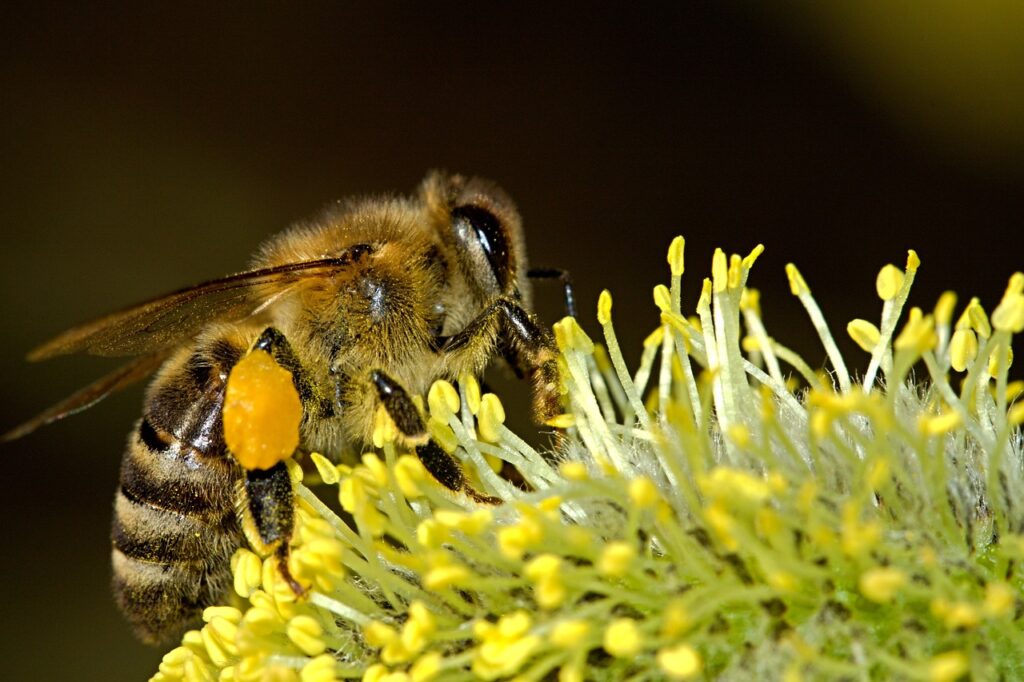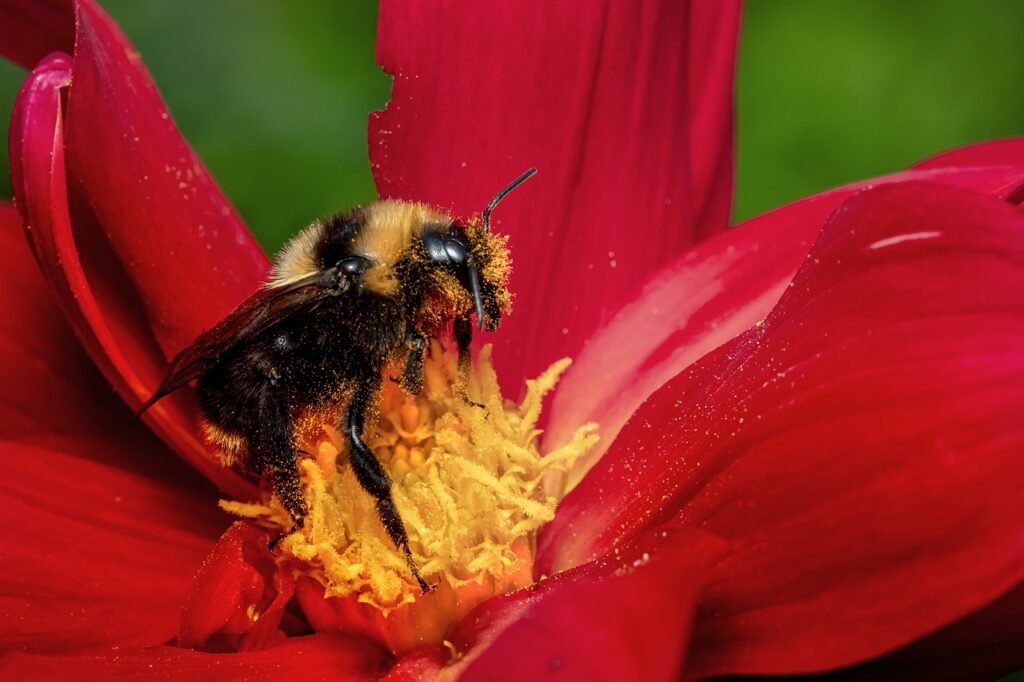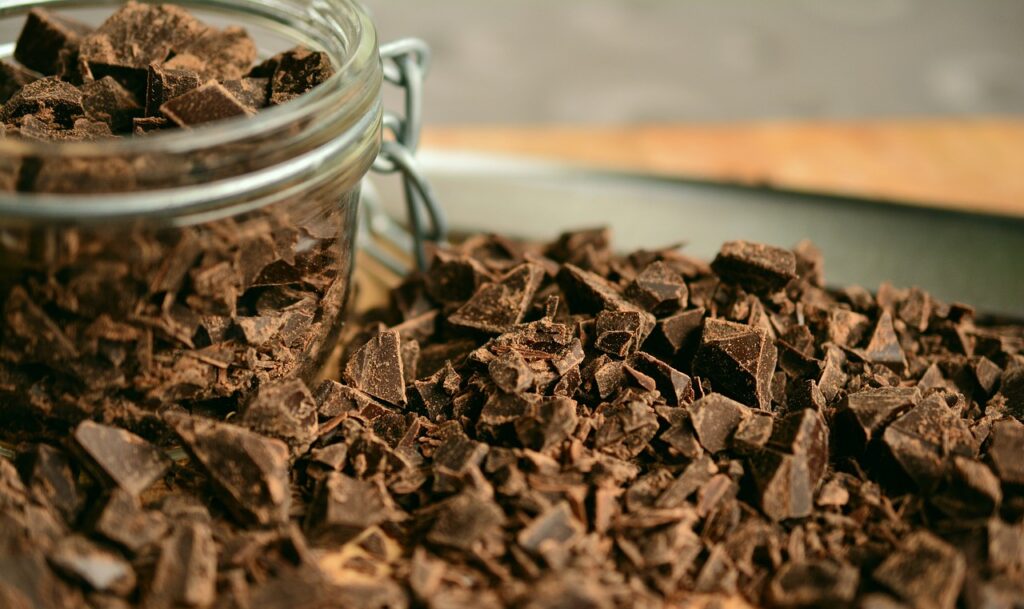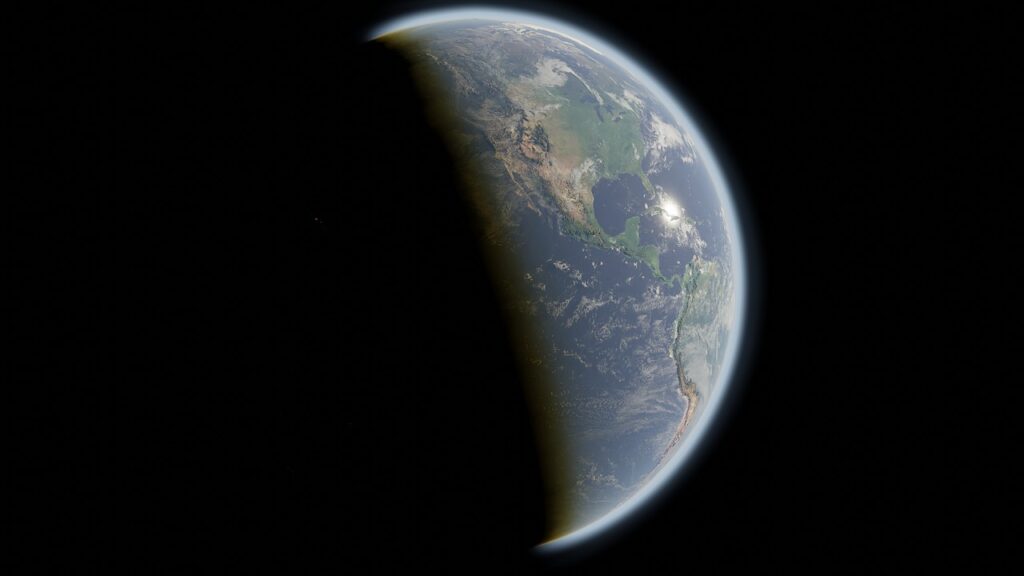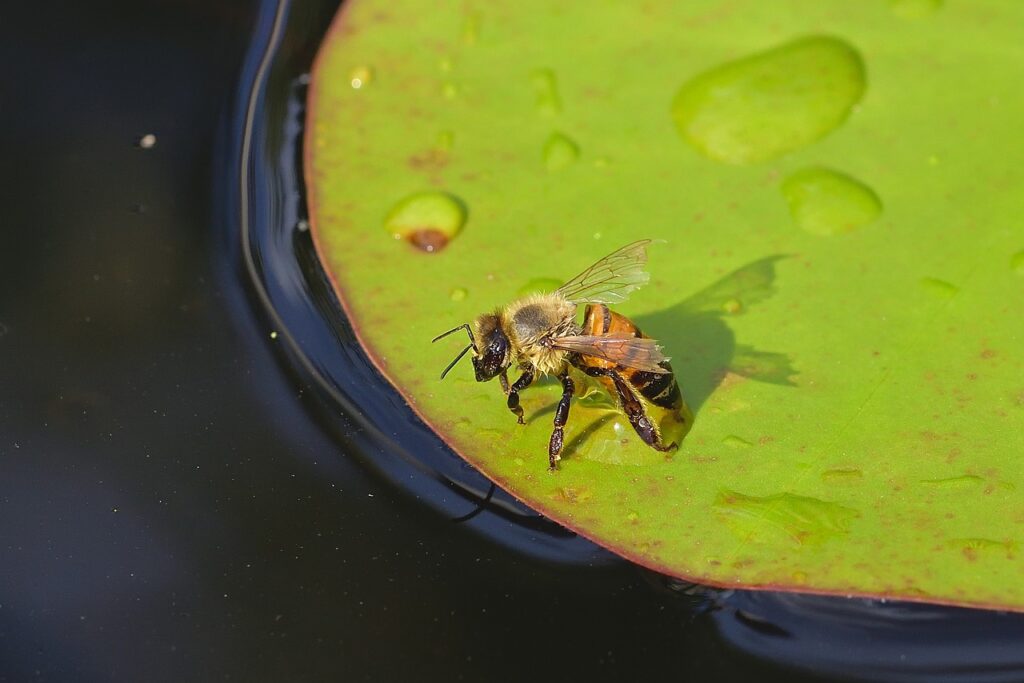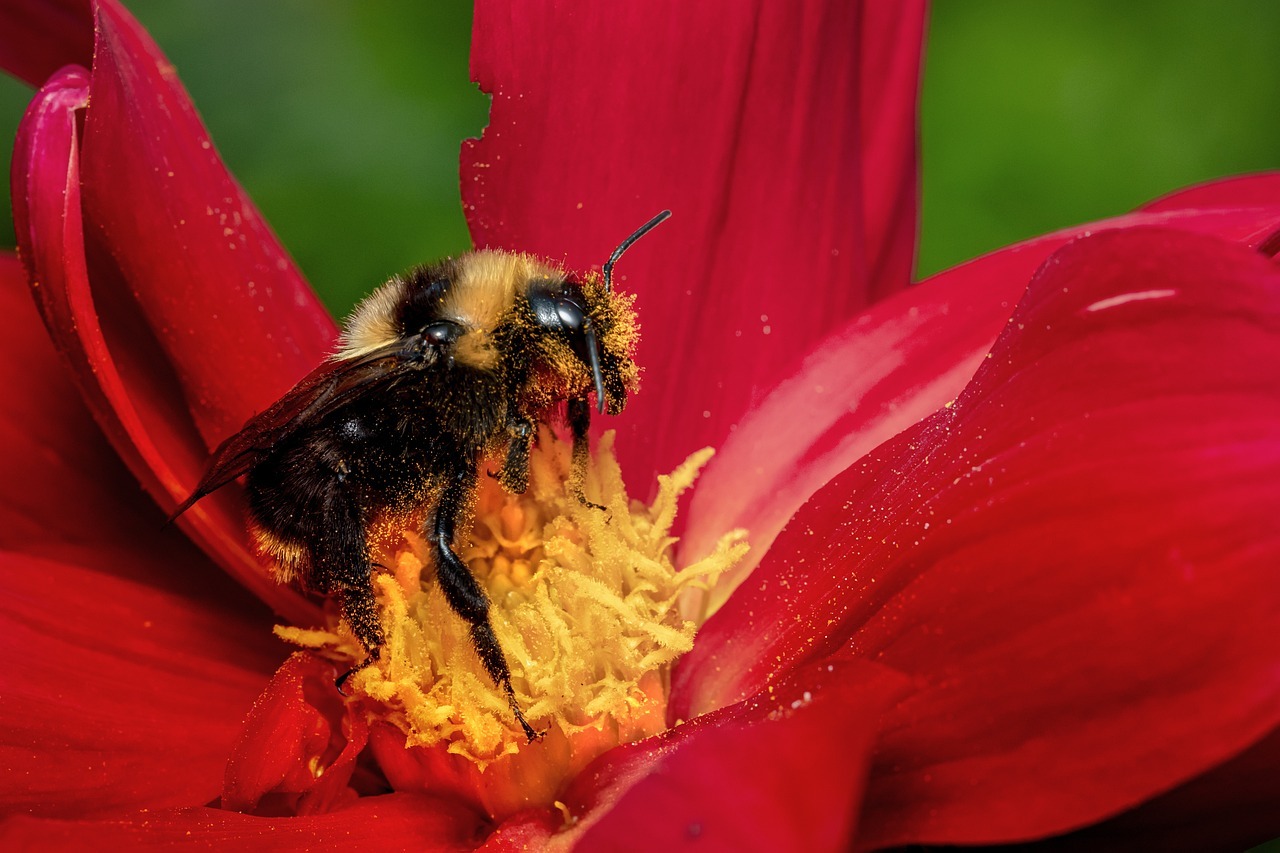
This month’s issue covers an essential topic (saving the bees) and is also packed with links to articles on different aspects of our environment. Check out those that pique your interest!
Our Friends, the Bees
I’ve enjoyed the showy, pink/purple flowers of Joe Pye Weed in front of my house for years and often stopped to watch the multitude of bees working the blossoms for nectar and pollen. In the fall I would gather the seeds and spread them to other areas in my yard. Last summer no bees came and no seeds were produced. I knew bees were in trouble but I’d never before seen the evidence so dramatically in my own yard.
What do bees need from us to help them thrive?
1. Stop the use of pesticides containing neonicotinoids (neonics) These chemicals are listed under a variety of names; Bayer is the largest producer of them. Ten states have banned their use but Virginia is not one of them. The Best practice is to USE NO PESTICIDES of any kind. Pesticides not only kill bees and butterflies but have been shown to cause cognitive problems in children when used in yards, parks, and playgrounds. Over the 20 years that I have cared for my current yard I have never used any pesticides and have had no insect problems. Nor are they used in our UUCville Native Plant Garden. Using native plants, which are more resistant to harmful native insects, is helpful. You can also encourage or buy ladybugs and invite birds and bats by putting up birdhouses and bat houses, all of which will help keep down the insect population.
2. Add Native Flowering Plants to your yard. They provide food for the bees – nectar for energy and pollen for protein and other nutrients. You benefit by the cross pollination provided by the bees as they move from flower to flower. Choose a variety of native flowering plants that bloom at different times during the growing season.
3. Provide Water For information on a simple way to do this see the Green Scene for Kids section below.
4. Provide Living Places for Adult Bees Leave a bare, tilled area in your yard or garden for the ground-dwelling bees, which includes most native bees. Leave a few pieces of dead wood outside and a brush pile for bees that prefer living in holes in wood and stems, or leave dead trees standing.
5. Put Up a Bee Hotel It provides a place for ground-dwelling bees to lay their eggs with a plug of pollen to feed the larvae when they hatch. You can make your own by searching the Web for “How to make a bee hotel” and following the directions. Or search for the article “Native and Solitary Bees of Virginia”, which has directions for making a simple type of hotel for Orchard Mason Bees, one of our most productive pollinators. You can order one from Nature’s Way Birds.com. if you’d prefer.
6. Donate to Organizations working to end the use of Pesticides This includes Environment Virginia, a member of Environment America, which is a leader in getting state legislatures to ban the use of neonics. Their next target state is Virginia. Send donations to: Environment, 543 Wazee St. # 430, Denver, Colorado 80202
And/or support the National Resources Defense Council (NRDC) .
7. Sign a Petition – tell Amazon to Stop Selling Pesticides! Amazon is the top seller of neonics in the country. To sign go here
Honey bees are natives of Europe, Asia, and Africa. They first arrived in America in 1620 and entomologists believe they were brought by the Pilgrims on the Mayflower. Native American bees do not create hives and most live in tunnels underground, many of them as solitary bees. Both honey bees and native bees are suffering from the same environmental pressures of pesticides, habitat loss, and climate change. The predominant species of Virginia’s native bees are the Bumble, Carpenter, Andrenid, Leafcutter, Sweat, and Orchard Mason. For almost all crops native bees are the primary pollinators or contribute significantly to the pollinating activities of the honey bees. Remember, our friends the bees are just doing their job of pollinating 75% of all flowering plants, including trees. Bees are not optional
Submitted by Johanna Woodchild
Environmental Good News Round Up
Central Virginia Farmers Cultivate Sustainability – Wesley Broome (11/8/23)
Central Virginia farmers are finding ways to grow a unique range of crops while implementing sustainable practices. As the state’s largest private industry, agriculture in Virginia continues to thrive thanks to its geography and the diverse farmers who act as stewards of the earth.
Seven Ways to Deal with Climate Despair – Angela Haupt, TIME magazine (2/6/24)
Many people are in flat-out climate despair. About two-thirds of Americans (65%) report being worried about global warming, according to a January report from the Yale Program for Climate Communication. It’s not irrational to be full of worry, rage, fear, guilt, or grief when the planet’s on fire. Climate-aware therapists share their most effective coping strategies for going from overwhelmed to empowered.
Fair Trade Chocolate Companies For Your Conscious Cravings – The Good Trade (2/29/21)
These conscious chocolate brands have made it an integral part of their mission to develop mutually beneficial partnerships by employing fair trade and direct trade practices with the farmers who cultivate their cocoa crops. Oh—and they make delicious good-for-you chocolate.
The 15 Best Electric Bikes for Every Kind of Ride – Wired (3/13/24)
For years bicycles were bulky, inconvenient, expensive machines with limited battery life. Slowly, that has changed. Ebikes are now lighter, more attractive, and more powerful than ever. You don’t need to be physically fit to ride one. They get you outside, reduce traffic congestion, and shrink your carbon footprint. I ride one daily to take my kids to school. They’re just fun.
America’s Top GreenTech Companies 2024 – TIME magazine
The booming green-technology sector has emerged as a beacon of hope, not only for investors—it’s predicted to grow to $9.5 trillion by 2030—and for the many workers it employs, but also for the planet at large. Greentech companies leverage innovation and new business models to curb greenhouse-gas emissions, displace unsustainable materials, and reduce the demand for nonrenewable natural resources. A new statistical ranking by TIME and Statista ranks 250 of America’s top sustainability-focused companies, based on their positive environmental impact, financial strength, and innovation, to see who is rising to the top of the field.
Mapping America’s access to nature, neighborhood by neighborhood – Harry Stevens Washington Post 4/10/24
Using satellite imagery and data on dozens of factors — including air and noise pollution, park space, open water and tree canopy — NatureQuant has distilled the elements of health-supporting nature into a single variable called NatureScore. Aggregated to the level of Census tracts — roughly the size of a neighborhood — the data provide a high-resolution image of where nature is abundant and where it is lacking across the United States. Interactive link lets you see your exposure to health-supporting nature
The Earth Bill –
The Earth Bill, officially called The Earth Act to Stop Climate Pollution by 2030, was introduced in the 118th Congress by Representative Espaillat (NY-13), with original cosponsors Rep. Velazquez (NY-07), Rep. Lee (CA-12), Rep. Nadler (NY-12), & Rep. Grijalva (AZ-07). It is a visionary, science-based law to mandate an end to climate pollution at the source – at the industry level – on the timeline required to save ourselves and the future.
The Earth Bill works by requiring utility companies and publicly-traded agriculture corporations to change to clean and healthy inputs in making our electricity (with solar, wind, geothermal,tidal, and wave) and food (with farming practices like no-till, cover crops, and no chemical fertilizers or pesticides). Think of it as the PEOPLE telling the GOVERNMENT to tell the ELECTRIC COMPANIES to GO 100% RENEWABLES. That order starts with the People – with us – because time has run out.
Which Sustainable Toilet Paper is Best? We Tested Them – Washington Post
You can now find toilet paper made of recycled paper, bamboo or other alternatives to virgin wood fiber, some of which can come from cutting down old trees in critical forests. Estimates suggest that logging these forests for products, including toilet paper, can release up to 26 million metric tons of carbon each year, according to the Natural Resources Defense Council, an advocacy group.The NRDC ranks dozens of toilet paper brands’ level of sustainability each year. We tested some of the top scorers on softness, strength and absorbency and found they varied widely.
The Green Scene for KIDS: Make a water bath for bees: Why? How?
A carpenter bee was struggling to get out of the water in the shallow dish of water that I had put out for birds and squirrels. Without help, it was going to drown. I put my hand under the bee and lifted her out. She shook her body and vibrated her wings to get the water off, then she walked up my hand and onto my sleeve, which dried her feet. Then she flew away. Now my home-made bird bath has an upside-down saucer in it so that bees and butterflies can stand on that, above the water, and drink. You can use a shallow bowl, a pie dish, or a plant pot drainage saucer. Smooth rocks also work well as a landing place. Be sure to check the dish every few days to change the water so mosquito larvae aren’t living there and to be sure it isn’t too deep after a rainfall. Carpenter bees pollinate tomatoes, eggplant, many other food crops, and flowers. Bees are too busy working to bother about stinging you unless they think you are trying to hurt them, so if a bee comes near you just stand still without waving your arms and the bee will soon be on its way.
Please let us know if you use any of our suggestions and if there are other topics you would like to see us cover!!

